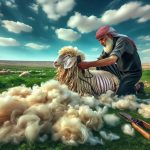I'd say wool is definitely a luxury material. Its fine fibers, enduring strength, and timeless sophistication make it a sought-after choice in both fashion and home decor. If you want to discover more about the qualities, historical significance, varieties, production process, and perception of luxury wool, keep on exploring!
Table of Contents
Key Takeaways
- Wool is sourced from specific sheep breeds for fine fibers.
- Skilled artisans produce wool with vibrant hues and enduring strength.
- Wool has historical significance dating back over 6000 years.
- Fine wool varieties like Merino and Cashmere are prized for their qualities.
- Wool is a hallmark of luxury in high-end fashion due to its durability and timeless appeal.
Qualities of Luxury Wool
Luxury wool, sourced from specific sheep breeds renowned for their high-quality, fine fibers, possesses exceptional qualities that set it apart in the domain of textiles. These sheep are meticulously bred and raised to guarantee the wool they produce is soft, durable, and of outstanding quality. The spinning and weaving processes involved in creating luxury wool fabrics are complex and demand skilled artisans to craft the final product.
The high-quality fibers of luxury wool result in fabrics that exhibit vibrant hues and maintain enduring strength and shine, even after repeated use. This resilience makes luxury wool a sought-after material in fashion and home decor. Its unmatched elegance and timeless sophistication have been cherished for centuries.
Through the careful selection and breeding of sheep, along with the intricate spinning and weaving techniques employed, luxury wool stands out as a premium textile choice that epitomizes quality and luxury in the world of fabrics.
Historical Significance of Wool
Wool holds a significant place in history, with its use dating back to ancient civilizations over 6000 years ago. Sheep were domesticated for their wool around 11,000 years ago, leading to the development of various types of wool. The global wool industry thrived in the Roman Empire and Middle Ages, with Italy becoming a hub by 1200 AD. The British Empire's introduction of sheep to Australia transformed the global wool trade, making Australia a key producer. Wool has been prized for its warmth, durability, and luxurious feel throughout history.
| Types of Wool | Breeds of Sheep | Historical Significance |
|---|---|---|
| Merino wool | Merino | Used in Roman Empire |
| Cashmere | Cashmere goat | Popular in Middle Ages |
| Angora wool | Angora rabbit | Sought after in Italy by 1200 AD |
| Alpaca wool | Alpaca | Introduced to Australia by the British Empire |
| Mohair | Angora goat | Transformed the global wool industry |
Fine Wool Varieties and Characteristics
Among the various fine wool varieties available, each possesses unique characteristics that cater to different needs and preferences.
- Merino wool is well-known for its softness, fineness, and breathability, making it perfect for base layers and activewear.
- Cashmere, a luxurious and lightweight wool, is excellent for insulation and is often favored in high-end fashion due to its rarity.
- Alpaca wool stands out for being hypoallergenic, water-resistant, and sustainable, offering superb thermal regulation and a soft feel.
Mohair, sourced from Angora goats, is recognized for its strength, luster, and wrinkle resistance, commonly found in suits and coats for its sheen. Vicuña wool, one of the rarest and most expensive wools available, is cherished for its exceptional softness, insulation properties, and sustainable sourcing from South America.
Each of these fine wool varieties brings something unique to the table, catering to the diverse needs and preferences of those seeking quality materials, especially in high-end fashion.
Wool in High-End Fashion
In the world of high-end fashion, wool stands as a versatile and cherished material known for its softness, warmth, and durability. High-quality wool fabric, made from natural fibers, is a hallmark of luxury in the fashion industry. Designers often choose wool for its insulating properties, making it ideal for creating elegant and functional pieces that exude sophistication. The use of wool in high-end fashion collections not only highlights the luxurious feel and natural sheen of the material but also showcases the impeccable craftsmanship and enduring quality associated with luxury garments.
Wool is a preferred choice for luxury coats, suits, and accessories, adding a touch of refinement and timelessness to designer collections. Its presence in high-end fashion reflects a commitment to using only the finest materials, emphasizing sustainability, and ensuring that each piece embodies enduring style. By incorporating wool into their creations, designers elevate their pieces to a level of sophistication that resonates with those who appreciate the artistry and elegance of luxury fashion.
Production Process of Luxury Wool
Sourced from specific sheep breeds prized for their texture, thickness, and strength, luxury wool undergoes an intricate production process involving skilled artisans and meticulous spinning and weaving techniques to create exceptional quality fabric.
- Merino sheep, known for their fine and soft wool, are a popular choice for luxury fabric production.
- The wool is carefully sheared from the sheep, then cleaned and processed to remove impurities.
- Skilled artisans expertly spin the cleaned wool into yarn, ensuring a consistent texture and quality throughout the fabric.
The production of luxury wool is a labor-intensive process that honors the traditions of craftsmanship and quality. Each step, from selecting the finest sheep breeds to the skilled artistry of spinning and weaving, contributes to the creation of high-quality fabric renowned for its elegance and durability. Through the hands of dedicated artisans, luxury wool continues to be a symbol of timeless sophistication in the world of fashion and design.
Pricing and Perception of Wool
Wool's status as a luxury material is underscored by its higher cost relative to other fabrics, reflecting its limited availability and costly processing stages that contribute to its esteemed reputation. The perception of wool as a premium material is further enhanced by its association with high-end fashion and quality garments. Factors like fine wool grade and intricate production processes add to the expensive pricing and luxury image of wool.
| Attributes | Description |
|---|---|
| Cost | Higher compared to other fabrics, limited availability, costly processing stages |
| Durability | Recognized for its long-lasting nature |
| Natural Properties | Wool's inherent characteristics like insulation and moisture-wicking abilities |
| Timeless Appeal | Continues to be a classic choice in fashion, transcending trends and seasons |
In the domain of luxury materials, wool stands out for its combination of quality, durability, and timeless elegance, making it a prized choice for high-end consumers.
Frequently Asked Questions
Is Wool High End?
Wool is considered a high-end material due to its premium quality and association with luxury brands. Its natural insulating properties and durability make it a sought-after choice in high fashion, adding sophistication and elegance to designs.
Is Wool Considered Expensive?
Wool is considered expensive due to limited availability, costly processing, and high labor expenses. Its premium status in fashion contributes to the higher price compared to cotton and synthetic fabrics. Wool's luxurious feel and durability justify its cost.
Why Is 100% Wool so Expensive?
Producing 100% wool involves labor-intensive stages like shearing and processing, leading to higher costs. Quality control measures and limited sheep production further drive up prices. These factors contribute to the premium pricing of pure wool.
What Fabric Is Used for High End Clothing?
For high-end clothing, fabrics like silk, cashmere, and fine wool are commonly used. These materials offer a luxurious feel, exceptional quality, and a touch of elegance. They are chosen for their premium look and superior attributes.
- The Best Fabric Pencil Cases for School, Art, and Work - June 25, 2025
- Where Can You Find Polaroid Camera Cases at Joann Fabric? - June 25, 2025
- Google Pixel Fabric Case vs. Speck Fabric Case: Which Is a Better Buy? - June 25, 2025






